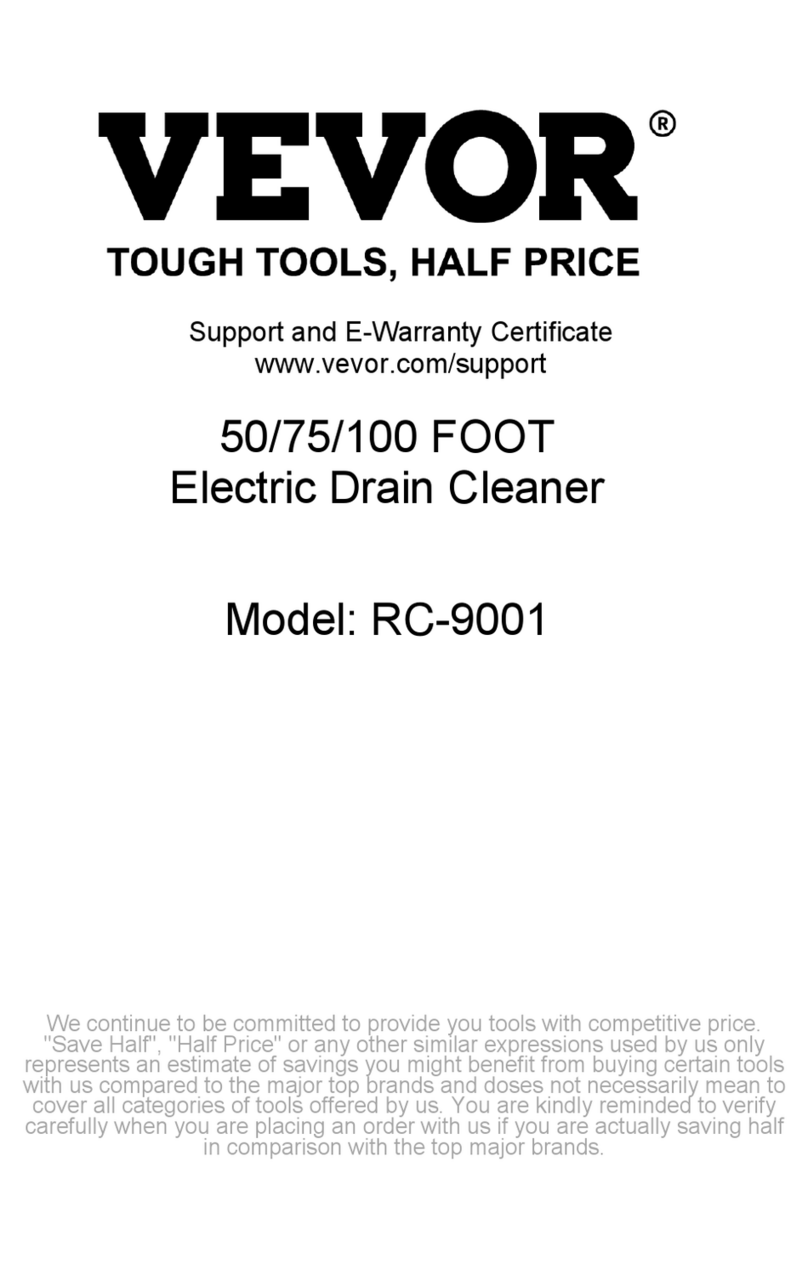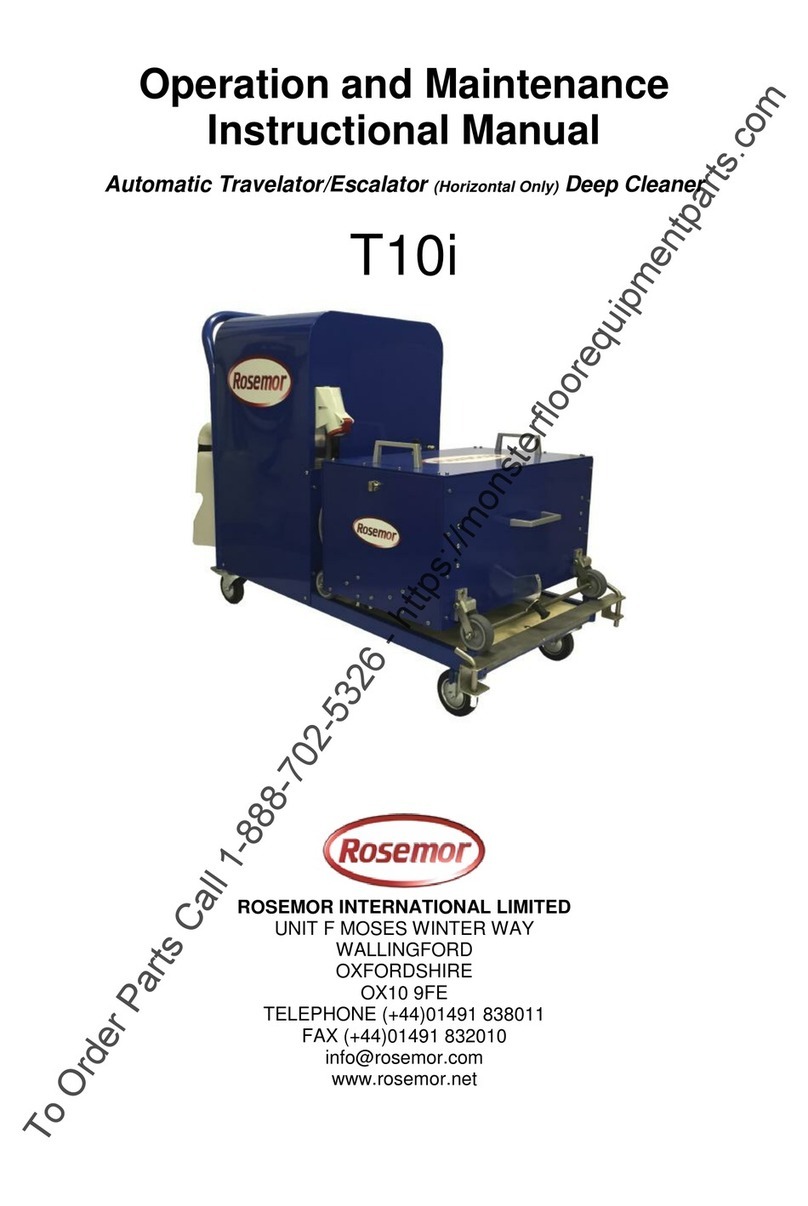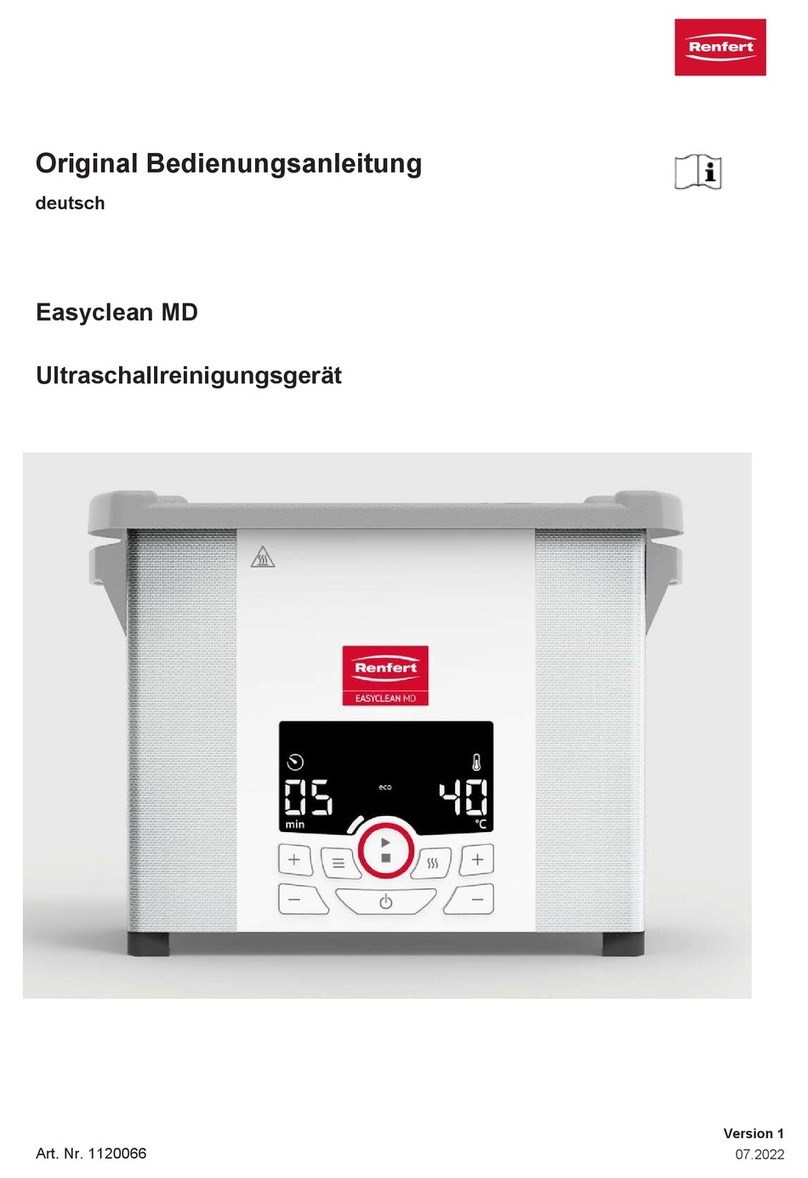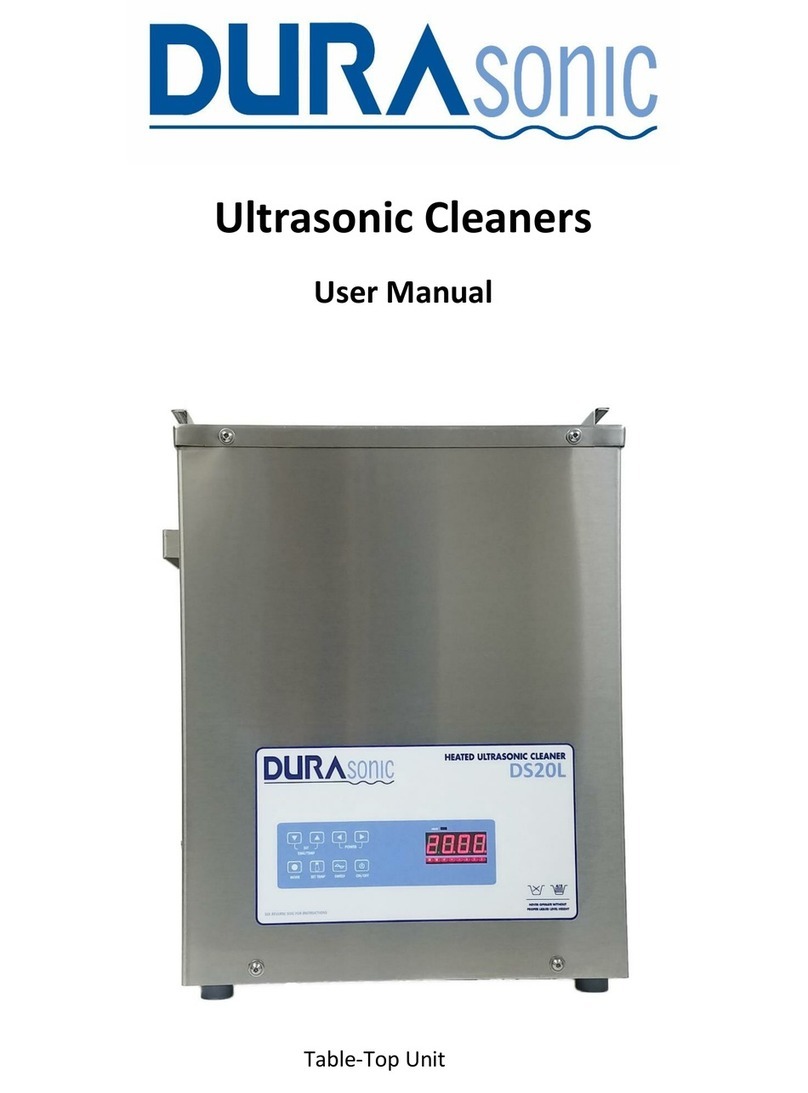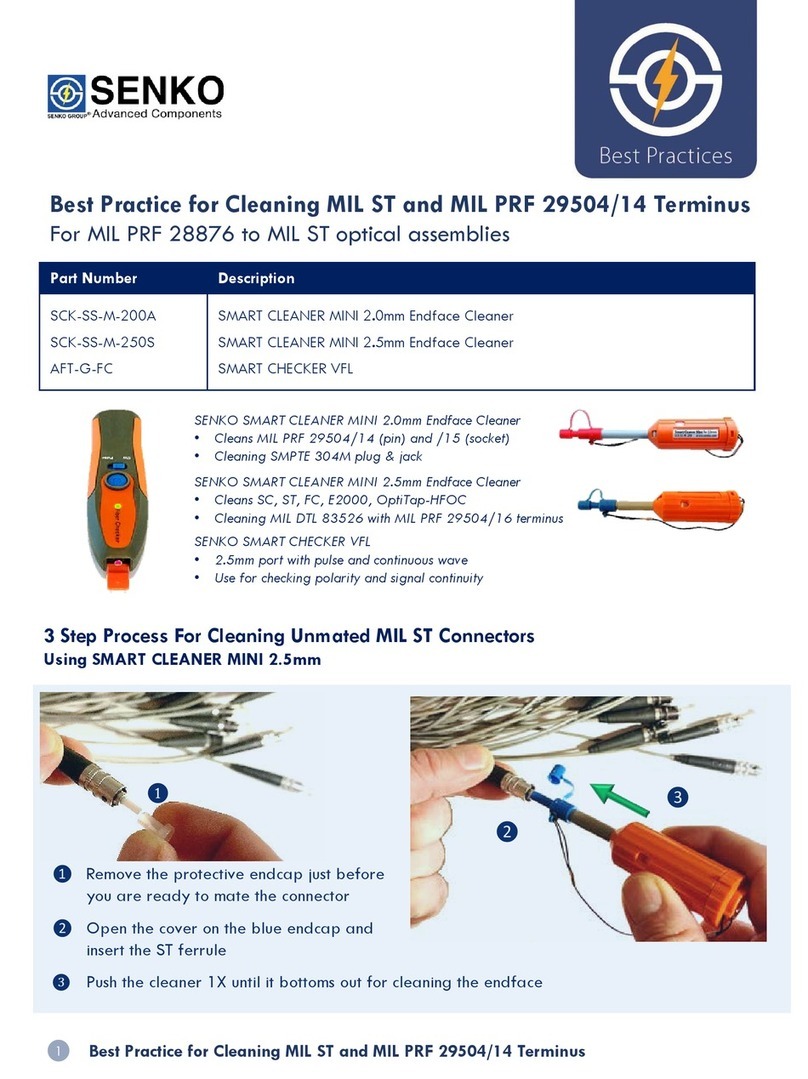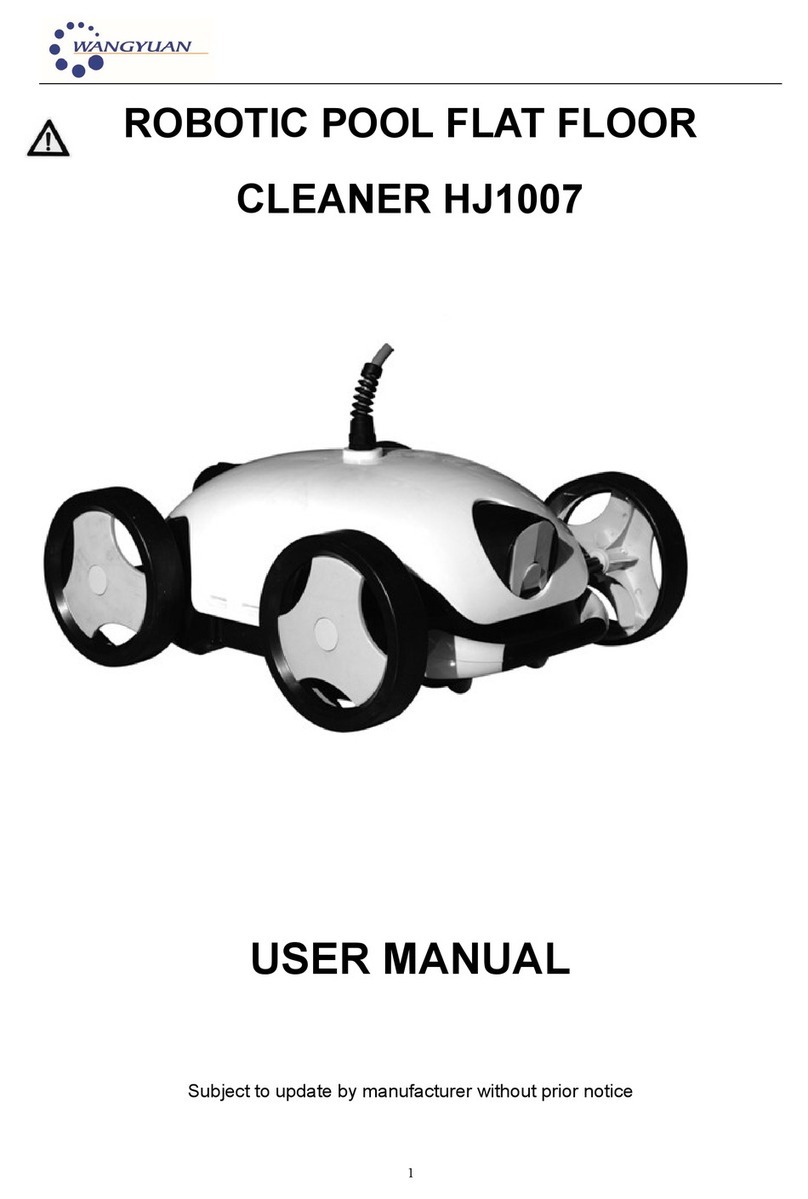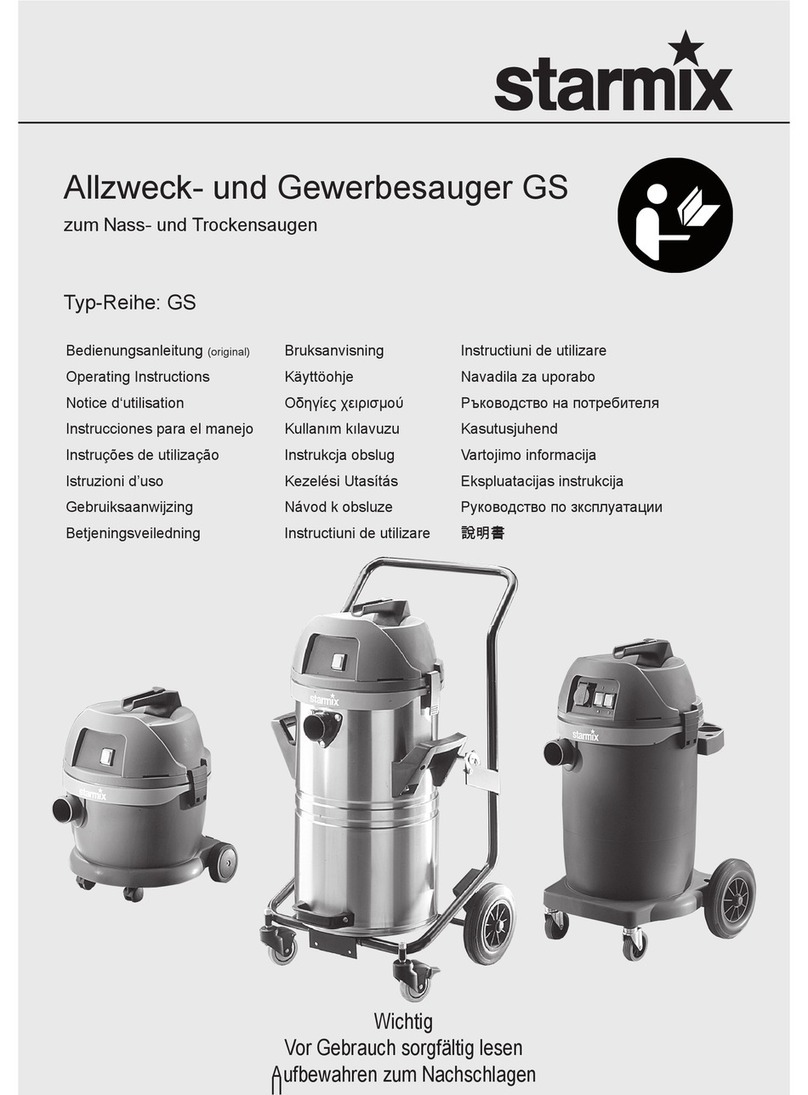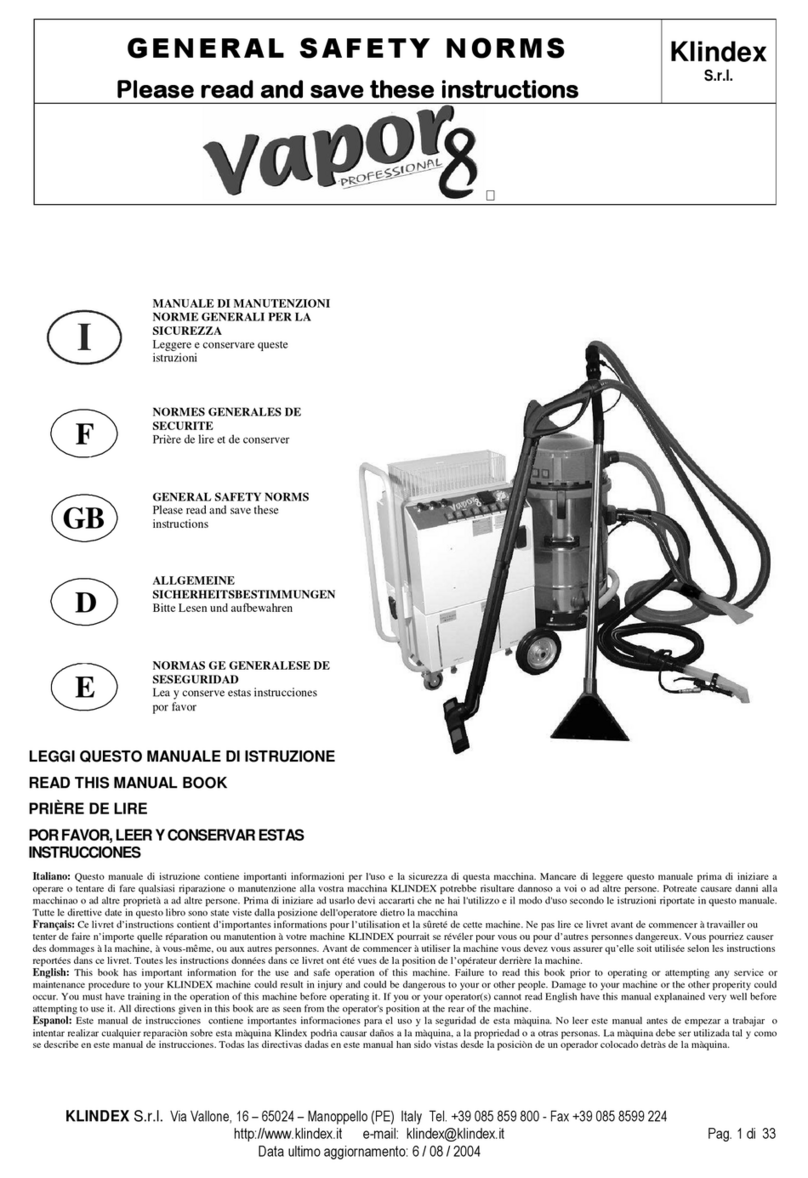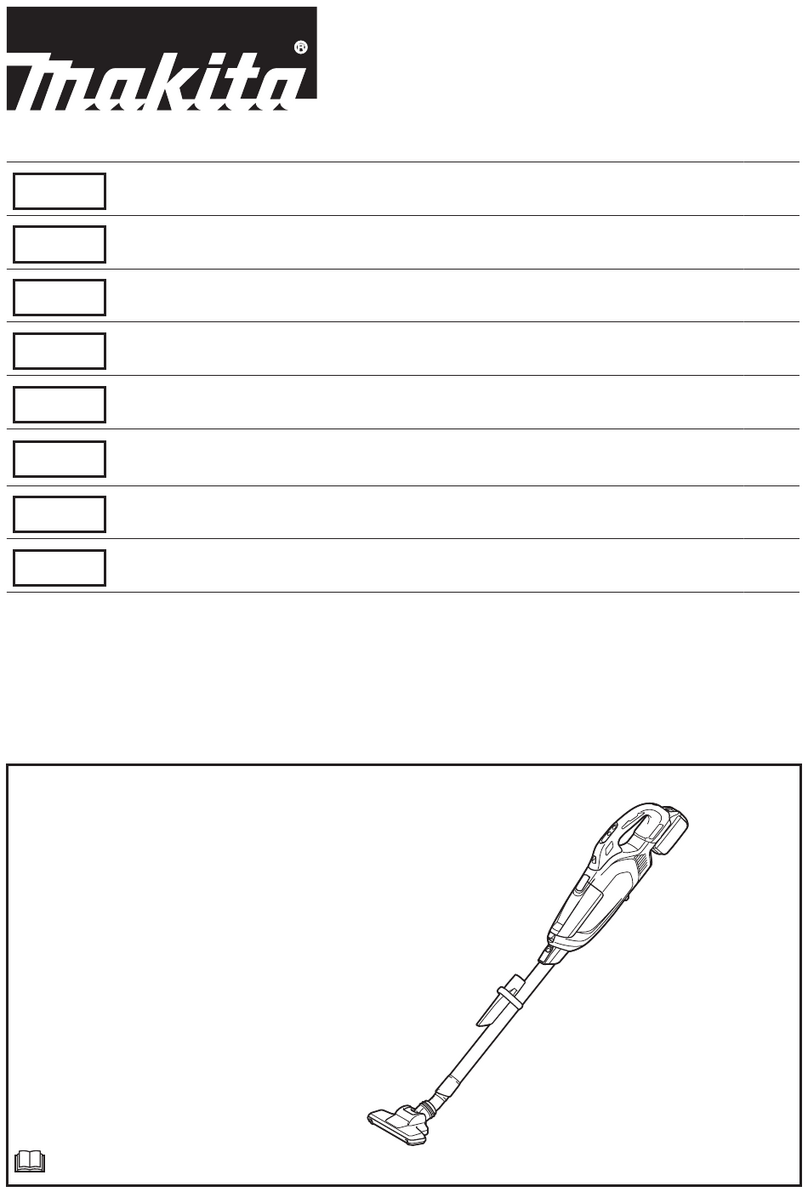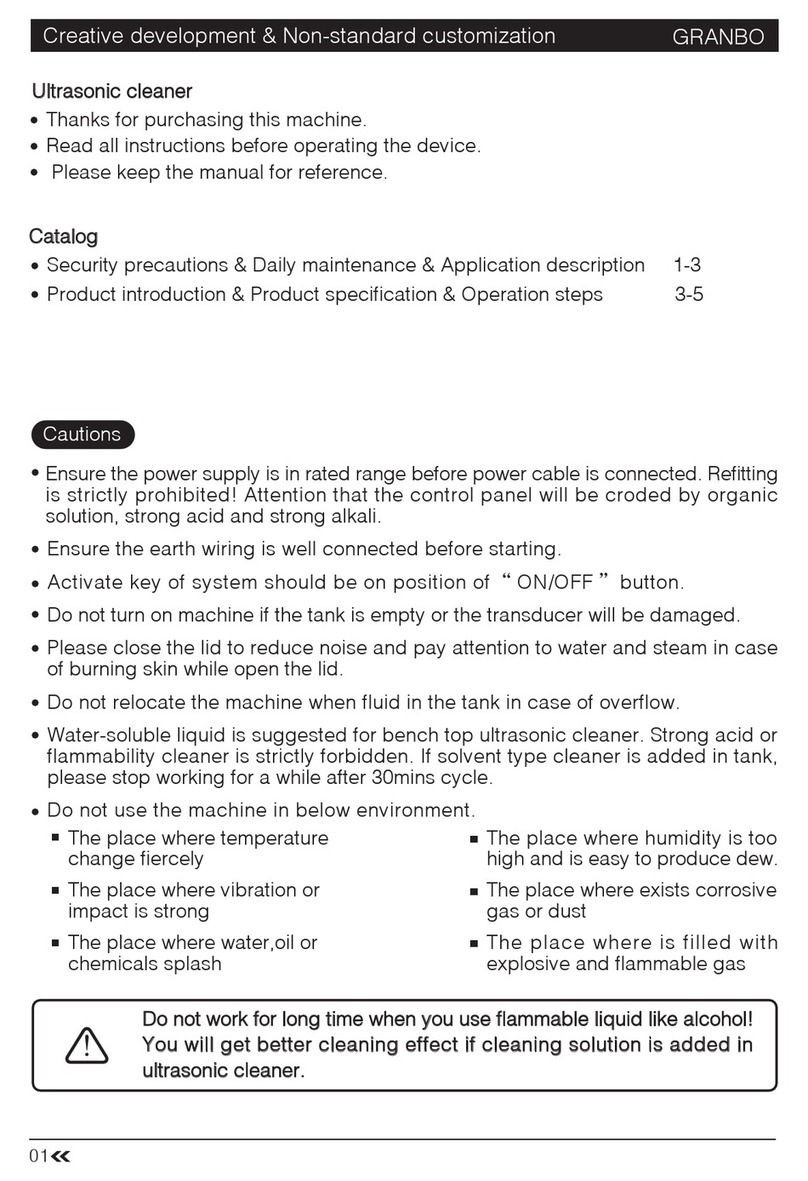RTI 4100 User manual

SERVICE MANUAL
TapeChek Model 4100
Betacam SP
Cassette Cleaner/Evaluator
Research
Technology,
International
Version 1.3

2
Table of Contents
______________________________________
Section: Page
1) Repair/Return Procedure 3 - 4
2) General Description and 4100 Specifications 5 - 10
3) Diagnostic Displays 11 - 14
4) Mechanical Adjustments 15 - 18
5) Defect Detector Module 19 - 21
6) Electronic Adjustments and Repairs 22 - 25
Appendices:
A) Primary Service Parts List
B) Circuit Diagrams

3
Repair/Return Procedure
__________________________________________
The Tapechek 4100 Betacam SP Evaluator/Cleaner is a professional unit for the high speed
processing of large and small Betacam plus Betacam SP (metal) cassettes. This machine is built to
the highest standards of quality and performance. It runs the tape at 25 times NTSC play speed
which translates to 120 inches per second. At these high speeds, at great deal of dust, loose oxide
and debris can accummulate in the machine which can cause some types of failures. TO PREVENT
MOST MACHINE PROBLEMS, CLEAN THE MACHINE MECHANISMS REGULARILY! Do
not, however, use flammable or corrosive solvents.
The machine is fully warranteed, when new (check your warranty statement) to be free of
manufacturing defects and to perform properly. If problems are found during the warranty period,
they will be handled according to the warranty. After the warranty period, RTI and its service
dealers will assist, at a reasonable charge, with parts and labor to address problems if they arise.
Telephone assistance is available, at no charge, to answer your questions.
In many cases the repairs can be done on location by simple replacement of a part or assembly.
However, sometimes the repair requires a critical adjustment or the trained eye of our factory
technicians. In these cases, the machine should be returned to RTI or one of its service dealers to be
repaired. Please note the following:
Important
_______________________
Call RTI or Service Dealer for assistance before
attempting any repairs to the machine. Our trained
personnel can, in many cases, diagnose the problem
on the phone! Call for a Return Authorization Number
before shipping unit to the factory.
If factory repair/return of your unit is required, you
must send the unit back in its carton with original
shipping materials, etc. to prevent shipping
damage!

4
SAFETY PRECAUTIONS
1. Read these warnings, the installation instructions, and the operating instructions before
using the model 4100. These precautions are for your own safety.
2. Follow all warnings and instructions marked on the product and in the manual.
3. Do not use this product in or near water, it may cause electrical shock.
4. Unplug this product from the power source before opening the case.
5. Do not place this product on an unstable cart, stand, or table. It may fall, causing personal injury.
6. Slots or openings in the cabinets are provided for ventilation. These openings must not be
blocked to insure proper operation.
7. Do not allow anything to rest on the power cord. Do not locate this product where people can step
on the power cord or trip on it.
8. If an extension cord is used with this product, be sure that the total ampere ratings of all the loads
plugged into the extension cord do not exceed the ampere rating of the extension cord.
9. Never push objects of any kind into the openings of electronic equipment as they may contact
dangerous voltages, causing a risk of electrical shock or fire. Never spill liquid of any kind on
this product or use flammable solvents to clean the mechanisms..
10. Save the shipping container and packing materials. In case unit ever requires factory
service, you must use these materials to assure proper packing.

5
GENERAL DESCRIPTION
Your TapeChek 4100 Cleaner/Evaluator will
process your NTSC Betacam and Betacam SP
tape cassettes at 25 times normal playing
speed (slightly higher for PAL tapes). The Pro
Line units accept both small and large
Betacam/Betacam SP cassettes.
CLEANING
The machine uses two sapphire burnishing
posts and three cleaning tissue stations which
have vacuum assistance. The burnishers
polish the tape thoroughly in forward and
reverse directions. There are two cleaning
tissues on the oxide (metal) side of the tape
and one cleaning tissue on the back side of the
tape. A vacuum system helps to transfer the
lose debris from the videotape into the fibers
of the cleaning tissue for more effective
dropout removal. Since most videotape
dropouts are due to dust, dirt and surface
contaminants, you will find that the TapeChek
4100 cleaning system will substantially reduce
the number of dropouts in your videotapes.
Older, more heavily used tapes will show an
even greater dropout removal.
DETECTION
In addition to the cleaning and polishing
systems, the TapeChek 4100 employs a very
sensitive defect detection system. This is an
optical defect detection system that will not
alter or affect pre-recorded tapes. The
videotape is inspected by a CCD(charge
coupled device) sensor which is capable of
detecting wrinkles, creases and edge damage.
Unlike other defect detection systems, the
CCD detector is very sensitive to longitudinal
creases, a common form of tape damage.
There are 64 elements, grouped into three
channels: Upper, Center, Lower.
Sometimes the defect will only appear in one
of the channels, however, a crease all the way
across the tape will count once in the Upper
channel, once in the Center channel and once
in the Lower channel. However, it will only
be counted as one defect in the total. Rather
than counting individual fluctuations in light
reflected from the tape, the machine counts the
number of seconds of videotape that contain
defects. This produces a more meaningful
defect report and display. For example, a
continuous edge damage might consist of 92
little variations in the tape over a one second
length of videotape. If the machine reported a
defect count of 92, one would think that the
tape is totally bad and unusable. But this is
not the case since only one second of
videotape was actually affected by the
damage.
SWITCHES/DISPLAYS
The back lighted LCD display offers many
different displays and operator messages.
There are three keyboards or "switch clusters"
on the front panel of the machine. The upper
switch cluster has the switches relating to tape
transport functions, such as Stop, Automatic,
Forward, Reverse, etc. The main power switch
for the machine is also located here. After the
operator carefully inserts the cassette in the
loading slot (centering a small cassette
between the raised guides), the operator will
typically push the AUTO switch to start the
automatic evaluating and cleaning cycle. (See
Operating Instructions Section).
AUTOMATIC OPERATION
After the tape is run to its end, the machine
will gently stop and automatically reverse. It
is during the reverse cycle that the defect
detector inspects the tape for physical damage.
Of course, the tape is cleaned and polished
during the forward and the reverse modes.
After the automatic cycle is finished, the
machine will eject the tape. It is then possible
to receive a printed report of the tape
inspection if the unit is equipped with the
optional printer.

6
TAPE CONDITION
The right hand keyboard shows the "A", "B",
and "C" tape condition lights. The factory
settings are such that a tape which has 0, 1 or 2
defects is considered an "A" tape, 3 through 9
defects are considered a "B" tape, and ten or
more defects is indicated as a "C" tape
condition. By pressing the SET-UP key the
operator may change the values for the "A",
"B", and "C" tape condition.
SMART ELECTRONICS
The TapeChek 4100 is a fully automatic
machine with sensors to detect cassette size,
erase protection tabs, and many other machine
functions. The POWER switch on the front
panel is actually under microprocessor control
as is the rest of the Pro Line machine
Therefore, if the POWER switch is turned off
while a cassette is in the machine, instead of
turning off immediately, the machine will eject
the cassette and then power down. Since the
entire machine is microprocessor controlled, it
is very gentle to the tape and monitors tape
tension and speed continuously during the
evaluation and cleaning cycle. Also, if a
cassette is inserted incorrectly, the machine
will automatically eject the cassette so that the
operator can try again. If a tape is loaded and
will not run, it is possible that one of the
cleaning tissues has been exhausted and needs
to be replaced. In this cases a message is
shown on the display panel.
MACHINE SPECIFICATIONS
TAPE TRANSPORT SYSTEM: 25 times NTSC Betacam tape speed
(approximately 120 ips.)
•Capstanless dual-motor spindle drive
•Metallic leader sensing system
•Tape accumulators prevent excess tape
tension and provide gentle tape handling.
•Tape speed and tension are constantly
monitored by microprocessor electronics.
•Infra-red detection systems for cassette size
and loading sensors.
•DISPLAY AND SWITCHES:-Six lighted
transport key switches
•LCD display (2 line by 16 char.) provides
operator messages and tape data.
Adjustable back light control.
•Three LED "Tape Condition" indicators.
•Tape data input keys and numeric keypad.
TAPE CLEANING SYSTEM: Two sapphire burnishing stations.
•Three vacuum-assisted cleaning systems.
•Automatic tissue advance in Forward and
Rewind.

7
DETECTION SYSTEM: Optical defect sensing system, using CCD
line array and associated electronics.
Detects longitudinal and transverse creases,
wrinkles, and other physical defects.
•Three-channel system identifies the area of
tape containing damage.
•location and number of defects are reported
on the display and by the optional printer.
OPERATOR CONTROLS: Three Switch clusters contain switches for
the tape transport system, display and data
entry systems, and the option printer
system.
ELECTRONICS:
•Microprocessor based control system with
ROM and battery backup RAM memory
devices. Digital electronics control all
motors, the transport system, defect
detection, keyboard, and displays. The
memory stores defect data and information.
DIAGNOSTICS SYSTEM:-The status of
all sensors and mechanisms in the Pro Line
machine is monitored and displayed on
special diagnostic displays seen on the LCD
module.
PRINTER OPTION: This optional electronics package and 20
column printer produces a printed report of
the tape inspection on special thermal
printing paper. (To prevent printhead
damage only use paper specified by RTI.)
ERASE OPTIONS: There are two erase options available for
the Pro Line machines. One designed for
oxide videotape and the other designed for
oxide and metal Betacam videotape. The
full width of the videotape is erased when
this function is selected by the operator.
Cassettes with erase protection tabs
activated will not be erased by the 4100.
The display will indicate "Erase Protected".
POWER: 117 VAC,3 Amp., 60 Hz. Standard
•220, 240 VAC; 50Hz. Special Order
DIMENSIONS AND WEIGHT
•W x 13" H x 20" D.
•pounds.

OPERATOR CONTROLS
TAPECHEK 4100 EVALUATOR/CLEANER
The following is a description of the push button controls and keys on the front panel of the
TapeChek 4100 Betacam unit.
TRANSPORT PANEL SWITCHES:
POWER This Power switch turns ON and OFF the main
power. When this switch is depressed, it lights
up and the main power is turned on to the
machine. If a video cassette is loaded into the
machine at the time the power switch is turned
off, the machine will automatically go through
a cassette eject cycle before the power is turned
off. This condition will be indicated to the
operator by a series of beeps at the time the
power switch is depressed.
EJECT: The Eject key initiates the eject sequence that
removes the cassette from the machine.
STOP: Depressing this switch will stop the tape from
moving in either the forward or rewind direc-
tions and Eject the tape if in the Erase mode.
AUTO: The Auto key initiates the automatic inspection
and cleaning of the videotape. In the auto mode
the tape is run forward to the end of the tape
and is then automatically rewound back to the
beginning. At the end of the auto cycle, the
videotape is ejected from the machine. At this
time a printed report can be obtained from the
optional printer system. If the auto switch (like
other switches) is depressed during the loading
cycle, the switch light will blink. After the
loading cycle is complete, the Auto and
Forward lights will light constantly, indicating
that the Auto mode has begun.
8

REW Depressing this switch will start the tape in the
rewind mode. The tape will move in high
speed rewind until the beginning leader is
detected. At this point the tape will stop.
FWD The forward switch will start the videotape
moving in fast forward. It will continue until
the tail leader is detected or another switch is
depressed.
MEMBRANE KEYBOARDS
The following descriptions are for the keys on the right-hand keypad located under the LCD Display.
This display shows defect and tape length information as well as various messages and diagnostics.
ERASE This Erase switch is used to initiate the erase
function on cassettes that are not erase
protected. To initiate the optional erase
function, the operator depresses the ERASE
key followed immediately by the AUTO
switch, followed again by the ERASE key. If
this sequence of 3 commands is made within 3
seconds, the machine will go into the ERASE
mode. Since the erase function is tied to the
auto function, the operator is insured that the
entire videotape will be erased.
RESET The reset key clears all of the defect data and
tape information from the memory of the
TapeChek 4100 machine. It also clears
information such as Tape # and Operator #
from the memory. The Date is retained until
the power is turned off.
CLEAR This key is used to clear incorrect data when
entering the Date, Operator # or Tape #. It
does not clear the memory in the machine of
other data, such as defect locations, etc.
DISPLAY The display key changes the information shown
on the LCD display. Pressing the display key
will sequence the operator through the various
displays available on the TapeChek 4100. (See
Page 11 - 14 in the Operator Manual )
9

" " This key is not used for normal machine
operation.
" " This key is not used for normal machine
operation. Depressing this key will indicate the
version of software in the machine.
TAPE CONDITION LED'S The "A", "B" and "C" tape condition LED's
are illuminated based on the total number of
defects found in the tape. The default para-
meters for these are: up to 2 defects, up to 9
defects, and 10 defects or more for the "A",
"B" and "C", respectively. These parameter
values may be changed by using the SET-UP
key and entering new 2-digit parameters.
The following descriptions are for the data entry keys on the left-hand key panel for the machine.
"0-9" KEYS This numeric keypad is for the entry of Date,
Tape #, etc.
TAPE # This key is pressed, followed by number keys
(up to 8 digits), to input the number of the
cassette being cleaned. The display shows the
data entry and the clear key may be used to
start over if a mistake is made. Depressing
other keys will get out of the Tape # entry
mode.
DATE Depress this key followed by numbers (6
digits) to enter the date of tape cleaning and
evaluation. Like the Tape # and Operator #,
the Date appears on the printed reports.
OPER # The operator key allows the entry of the
operator number, if applicable. 4 digits.
SET-UP This key is used to alter the defect values for
the "A","B" and "C" tape condition lights. This
key is also used (after entering six 9's in the
date) for diagnostic displays, see page 13.
" X " This key is used when the display is in the
"Defect Location" mode to sequence through
the machine memory of defect locations.
" Y "
10

The "Y" key sequences through the defect
locations in reverse order.
Displays
The diagnostic displays built in to the Tapechek 4100 have been carefully designed to assist our
factory trained service technicians in diagnosing problems that may, from time to time, arise with the
machine. There are two basic types of displays in this catagory: 1) Status and warning messages and
2) Coded diagnostic readouts.
STATUS MESSAGES
READY LENGTH
TO RUN 0:00
This message is the first display to be seen
flashing as the machine is turned ON. This
wait message indicates that the machine is
initializing the various mechanisms in the unit.
It will cycle the carrier, spindle motors, cleaner
assembly and others as necessary.
The machine is now ready to accept a tape
cassette. The operator may now load a tape. If
a small cassette, carefully center the cassette
and push into the loading slot. The motorized
loading system will pull in the tape and lower
the carrier.
The tape is being loaded into the mechanism.
You may press the AUTO, FWD or REV keys
while the tape is loading. This display flashes
until the tape threading is complete.
The tape has been loaded into the machine and
the machine is in the Idle mode(neither AUTO,
FWD or REV has been selected).
* * * WAIT * * *
NOT READY
FORWARD/CLEANING
>>>>>-- 2:30
The machine is running the tape in the AUTO
forward direction and is counting the tape
length. In the manual FWD mode, the length
counts downward.
TAPECHEK Proline
READY -- LOAD TAPE
REWIND/CLEANING
---<<< 13:45
The machine is running the tape in the reverse
direction in the manual REV mode. The tape is
being cleaned and polished also.
This display flashes during the Eject cycle.
When the Eject is complete, the normal display
will appear. The machine will not allow
* * * WAIT * * *
TAPE LOADING
PLEASE WAIT
TAPE EJECTING
11

transport keys to work but you can select a
printout during this cycle.
This is the normal display during the AUTO
reverse mode when defect inspection is actually
occuring. To see individual channel defect
counts, press the DISPLAY key.
OTHER DEFECT DISPLAYS ARE
DESCRIBED IN THE OPERATOR'S
MANUAL...
__________________________________
ERROR MESSAGES
This (along with the beeper) warns the operator
that at least one of the tissue rolls has been
exhausted. The machine will complete the
current run of tape but will not allow another
tape to be run until the new tissue roll has been
loaded. See inside cabinet lid for directions.
UP CEN LOW TOT
12 09 11 012
DEFECTS LENGTH
013 26:34 This display shows the defect counts in
individual channels. The operator may switch
back to the Total Defects/Length display at any
time during the rewind cycle or after the tape
has been ejected.
_____________________________________
This message warns the operator that the
cassette erase protect tab has been pushed in.
The machine will go into the AUTO mode but
will not erase the tape. Under these circum-
stances, this display is seen during the forward
AUTO mode until the machine starts to rewind
the tape.
**WARNING TAPE**
ERASE PROTECTED
***TISSUE LOW***
CHANGE ROLL
12

The following diagnostic displays are available to verify the status of the various machine senors and
to verify what the microprocesser is calling for at any given time.
To see these displays, enter all 9's in the Date and press SET-UP.
DIAGNOSTIC DISPLAY #1
MACHINE SENSOR READOUTS indicate the state of the various sensors in the tape transport
mechanism. When an individual letter is capitalized, it means that function is "true"; when letter is
small, it means that function is "false".
AiO LuD SIo Elrt
eeeDiple HsL TuD
First line:
"AIo" - Threading Arm
In
"AiO" - Threading Arm Out
"LUd" - Cassette Lift
Up
"LuD" - Cassette Lift Down
"SIo" - Spindles
In
"SiO" - Spindles Out
"ElRT - Leader Sensor
Right and Out of Tissue
"ELrt - Leader Sensor
Left and Not Out of Tissue
Second line:
"E--" - Large special recognition opening (in Digital,SX and other formats)
"--M" - Small cassette, metal tape, Erase OK
“-S-“ Small cassette, oxide, Erase OK
"DiPle" - Cassette fully
In, Cassette Present,
Small Cassette Size, set for Digital cassettes
"DipLZ" - Digital, Cassette
Not Fully In, Not Present,
Mechanism set for Large Size, Not erase protected
"HLL" - Hub Size
Large
"HsL" - Hub Size Small
"TuD" - Tissue Mechanism
Down
"TUd" - Tissue Mechanism Up
15

DIAGNOSTIC DISPLAY #2
94 41 42 6B CC 0
LRCOiET 58 12:26
For diagnosing problems in the tape transport mechanism, this display helps the service technician.
The meaning of the above sample information is as follows:
"94" - MACHINE MODE; Indicates AUTO FWD, AUTO REW, REWIND,
MANUAL FWD, etc. in code numbers.
"41" - Actual TAPE SPEED; in code numbers.
"42" - SPEED being called for by microprocessor ; in code numbers.
"6B" - LEFT MOTOR POWER; Indicates amount of power being called for by
the microprocessor. "10" represents an idle condition, "FD" indicates
almost maximum power.
"CC" - RIGHT MOTOR POWER; same as above, but for
the right hand spindle motor.
"0" - CASSETTE SIZE; small or large.
"0" - Small Cassette, Small Hubs
"1" - Small Cassette, Large Hubs
"2" - Large Cassette, Small Hubs
"3" - Large Cassette, Large Hubs
"58" - TAPE TENSION; "58" typical in FWD, "35" typical in REV
"12:26" - - Normal TAPE LENGTH display(not used for diagnostics)
“LRCOIET” These are diagnostic codes for factory use.
15

Mechanical Adjustments
15

GENERAL
The TapeChek 4100 transports the videotape at approximately 120 ips. The machine also has many
mechanisms which are operated by 11 different motors. We have tried to design the product with
assemblies to be self-adjusting where possible, but, obviously, some parts of the machine do require
adjustment if new parts or assemblies are installed.
In general, anything in the threading path of the videotape that touches the tape should be
perpendicular to the transport panel. The exceptions to this rule are the crown threading arm rollers
and the tape tach timing assembly. The operating tape path height is 1.145" from the bottom edge of
tape to the top of the transport panel.
CASSETTE CARRIER
The carrier should be aligned with the opening in the front panel of the machine. If it is not,
cassette may not load properly. To adjust the carrier height, up and down, so that it matches the
opening of the front panel, the entire transport panel is raised and lowered by moving its mounting
brackets on the left and right sides of the bottom part of the cabinet. This adjustment is made when
the carrier lift assembly is in its full "up" position.
The left/right position of the carrier is determined by 2 small brackets which have black plastic
rollers that ride on the sides of the carrier assembly. The carrier brackets are adjusted left and right
so that when the cassette is lowered onto the transport panel, the cassette is in alignment with the
cone shaped support pins and other sensors on the transport panel. Using just the bottom half of a
Betacam cassette shell will show when the carrier is in alignment with the transport mechanism.
The carrier floor is adjustable by its four mounting screws to the carrier arms. This adjusts the
position of the carrier floor (and the cassette) toward the front or back of the machine. These four
screws also allow you to adjust the height of the carrier floor when the carrier is in the down position.
In the down position the carrier floor should drop away from the video cassette and leave
approximately a 1/16" gap between a small cassette shell bottom and the carrier floor so that the
cassette is solely resting on the support posts of the transport panel.
MAGNETIC HEADS (Optional)
The face if the magnetic heads should be square to the panel as measured with a triangle or other
square block. This is also true for the tape guide post next to the moveable erase head. Also, the head
should be adjusted so that the wrap of the tape is sufficient to cover the black area of the face of the
head.
Head
Tape Wrap
The angle of the tape going into the head should also be approximately equal to the angle of the
tape leaving the head. This is adjusted by the mounting screws for the head itself. It is normal for the
22

tape to move up and down slightly on the head without effecting erasure. The heads are built over-
size to accommodate this.
22

TENSION SENSOR
The tension sensor, arm and pin, is connected to a potentiometer and pushes against a leaf spring.
This assembly measures the tension of the tape as it runs through the mechanism. The pin that
touches the tape must be perpen-dicular to the transport panel. With the machine in the
diagnostic(display #2) mode, the front panel readout for the tension sensor should be "00" or "01"
when the tension arm is at its rest position. If not, the set screw that connects the arm to the
potentiometer shaft should be loosened and the shaft of the potentiometer changed to achieve the
"01" reading on the display.
The spring should be adjusted so there is a slight pressure against the arm at the rest position and
that there is a force of 45 grams at the middle of the arm's travel when measured at the tape guide pin.
The squareness of the threading arm pin can be most easily adjusted with .010" thick washers on the
three mounting support spacers that mount the tension potentiometer assembly to the panel.
THREADING ARMS
The threading arms are spring loaded so that the arm wheels should be pressing lightly against the
transport panel at all times. It is most desirable that both wheels on the threading arms be in contact
with the panel. However, this may not be true when the tape is threaded and the tape tension pulls on
the threading arm slightly. It is normal for the rear wheel to lift off the panel slightly and touch the
underside of the threading arm guide plate.
THREADING ARM ROLLERS
The blocks of metal that hold the threading roller should be close to perpendicular to the transport
panel, however, there may be slight variations to this as the roller was adjusted for proper tape travel.
The angle of the threading
22

arm roller is adjusted by tilting the pulley mounting block fore and aft and then securing the two 4-40
screws that hold the block to the arm. When adjusting the angle of the roller left or right, the
adjustment is made by carefully bending the vertical member of the threading arm so that the tape
travels in the middle of the roller or touches either flange lightly.
Under no circumstances should the tape press against the flanges of the roller hard enough to
buckle or deform the tape. You will find that tilting the mounting block for and aft will adjust the
position of the tape on the roller when a tape is going in the forward direction; and in the reverse
direction, angling the arm left or right will affect the tape travel.
THREADING ARM SWITCHES
In addition to the rollers, the "in" and "out" microswitches should be adjusted to switch
approximately 3/16" prior to the arm reaching either its "out" position or its "home" position. The
threading arm is connected to the threading motor via a clutch(set to slip at 11 oz.), and the threading
motor will continue to run for a brief period after the arm "in" and arm "out" microswitches actually
switch.
TAPE BACKUP SUPPORT BLOCK EFFECTS DEFECT DETECTION
The black support block with the sapphire support rods also needs to be square to the transport panel.
Remove the detector to check the rods for squareness(90°to the panel.) The machine automatically
brings the detector backup block into position when tape is not threaded. It is very important that the
rods that support the tape at the detector be perpendicular to the transport panel.
The following sketch shows the moveable cleaner and the tape back-up support block with the
sapphire rods.
Cleaner
90
Main panel
rods
Shims
.
This adjustment is made by adding or removing shim washers from the pivot bracket of the
moveable cleaner assembly underneath the transport panel.
CASSETTE HEIGHT
The height of the cassette is determined by the 6 support posts on the transport panel. These
hexagonal posts are fixed and not adjustable. For proper operation of the 4100 machine, it is
imperative that the cassette be in contact with these support posts, not the carrier floor.. NOTE: The
large cassette has a total of six support posts. Obviously, because of variations in the large cassette
housing it is not totally flat and, therefore, if four of the six posts touch the cassette, that is sufficient
to support the cassette. 22

SPINDLE HEIGHT
The spindles of the machine that drive the reels inside the cassette should be at .990 inches above
the transport panel. This measurement is made from the top of the spindle flange down to the top of
the transport panel. The spindle should be at this height, plus/minus .004 inches.
CASSETTE PLUNGER SENSORS
There are five plunger-type microswitch sensors underneath the cassette. These sensors sense
large/small reel hubs, metal/oxide tape and the erase tabs for small and large cassettes. For proper
operation, these microswitches should switch approximately 1/32" prior to the cassette coming down
on its support hex post. Also, check for the free action of the plunger. The plunger should not be
sticky and should return to its full upright position easily. DO NOT LUBRICATE THE
PLUNGERS, that causes them to stick due to the tight fit in the tube. Clean, dry plungers are
desired.
SPINDLE MOVERS
The spindles are moved to accommodate the large cassette via a gear motor and cam arrangement
with a straight arm linkage. The cam has a detente and two microswitches to stop the cam at the
appropriate position for the two sizes of cassettes. The arms of the microswitch may have to be bent
slightly (when installing a replacement switch) so that the switch operates reliably in the detente of
the cam.
Slide Cam
Linkage
.
.
The linkage should be in a straight line from the pivot point of the cam to the spindle slide in the
"in" and "out" positions (180°apart). Check that both spindle cams are in the same relative position.
If they are not, the timing belt may have to be adjusted. This is accomplished by removing the
bearing roller that rides on the timing belt, cause slack in the belt and manually rotate the right-hand
spindle until the proper orientation is achieved. Then reattach the timing belt bearing roller.
WARNING: Keep your hands and clothing out of the slides when they are operating.
CARRIER LIFT ASSEMBLY
The carrier is moved up and down by a gear motor with gears and linkage arms underneath panel.
The rotating arm is connected to the carrier via round linkages that are covered by a spring. When the
carrier is in the "down" position, the spring extends to add further down pressure, holding the cassette
in place. The rotating linkage should be approximately vertical when the carrier is in the up position
and straight down when the carrier is in the down position. The carrier lift motor is turned "on" and
"off" via two optical sensors on the back edge of the carrier floor. A tall "U" shaped bracket
interrupts the two optical sensor beams and causes the carrier to stop in the up and down position,
respectively. Once the "flags" of this "U" shaped bracket are trimmed to the proper the height at the
22

